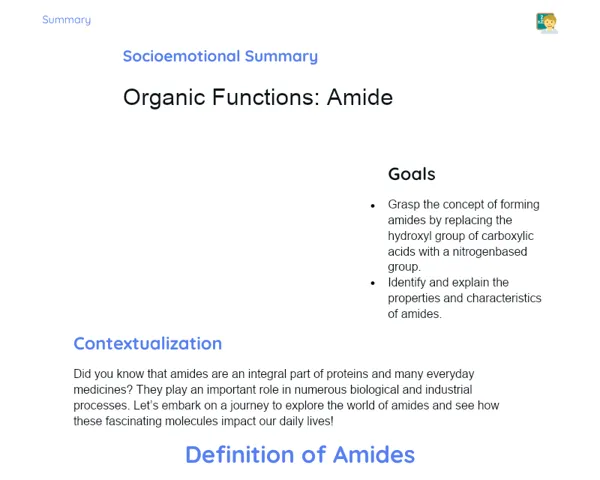Goals
1. Differentiate between pi and sigma bonds in organic molecules.
2. Understand how pi and sigma bonds affect molecular properties and shape.
3. Count the number of pi and sigma electrons in different organic molecules.
Contextualization
Pi (π) and sigma (σ) bonds are essential concepts in organic chemistry, playing a crucial role in defining the chemical and physical characteristics of molecules. A solid grasp of these bonds allows us to explore a range of applications, from the structure of proteins to the functionalities of advanced materials. For example, the behavior of polymers and the reactivity of medicines are heavily influenced by these bonds. Thus, it’s vital for students and professionals in academia, as well as the chemical and pharmaceutical industries, to master these concepts.
Subject Relevance
To Remember!
Sigma Bonds (σ)
Sigma bonds (σ) result from the head-on overlap of atomic orbitals, creating a direct connection between two atoms. These bonds are more robust and stable than pi bonds (π) because of the greater overlap of electrons. Sigma bonds allow molecules to rotate freely around the bond axis, ensuring a stable geometric structure.
-
Formed by head-on overlap of atomic orbitals.
-
Stronger and more stable than pi bonds.
-
Permit free rotation around the bond axis.
-
Found in all single bonds, as well as in double and triple bonds.
Pi Bonds (π)
Pi bonds (π) arise from the side-to-side overlap of unhybridized p orbitals, situated above and below the sigma bond axis. They are weaker compared to sigma bonds due to less effective overlap. Pi bonds limit the rotation of molecules around the bond axis and contribute to distinctive properties, including chemical reactivity and the formation of conjugated systems in organic compounds.
-
Formed by side-to-side overlap of unhybridized p orbitals.
-
Less stable than sigma bonds.
-
Restrict rotation around the bond axis.
-
Present in double and triple bonds.
Molecular Geometry
The shape of a molecule is influenced by the presence of sigma and pi bonds. Sigma bonds establish the fundamental structure of the molecule, whereas pi bonds can introduce rigidity and flatness. The geometry of a molecule plays a direct role in determining its physical and chemical characteristics, such as melting point, boiling point, and solubility.
-
Basic structure determined by sigma bonds.
-
Rigidity and planarity introduced by pi bonds.
-
Influences physical and chemical properties of substances.
-
Important for the reactivity and stability of molecules.
Practical Applications
-
Pharmaceutical Industry: Knowledge of pi and sigma bonds is crucial for designing and developing new medicines, influencing their interactions with enzymes and biological receptors.
-
Advanced Materials: Manipulating pi and sigma bonds enables the creation of materials with desired properties, such as heat-resistant polymers or flexible plastics.
-
Materials Engineering: The contrast between graphite and diamond showcases how sigma and pi bonds impact material characteristics, affecting hardness, electrical conductivity, and other features.
Key Terms
-
Sigma Bonds (σ): Bonds formed by the head-on overlap of atomic orbitals.
-
Pi Bonds (π): Bonds formed by the side-to-side overlap of unhybridized p orbitals.
-
Molecular Geometry: The spatial arrangement of atoms in a molecule that influences its physical and chemical properties.
-
Chemical Reactivity: The capacity of a substance to engage in reactions with others, forming new compounds.
Questions for Reflections
-
How do pi and sigma bonds affect the reactivity of a molecule in certain chemical processes?
-
In what ways can we manipulate pi and sigma bonds for developing new materials with specific qualities?
-
Why is it important to understand molecular geometry when predicting the physical and chemical properties of new substances?
Practical Challenge: Building and Analyzing Molecular Models
To reinforce your understanding of pi and sigma bonds, you’ll engage in a hands-on challenge to build models of organic molecules and identify the types of bonds present.
Instructions
-
Form groups of 3-4 students.
-
Use molecular modeling kits to create models of C2H4 (ethylene), C2H2 (acetylene), and C6H6 (benzene).
-
Identify and label the sigma (σ) and pi (π) bonds in each model.
-
Discuss as a group the properties and molecular geometry linked to each type of bond.
-
Present your models and conclusions to the class.



